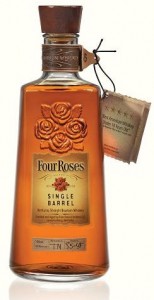Four Roses Private Selection Single Barrel Review
By Elizabeth Emmons

(Credit: Kirin)
Four Roses Bourbon has a longstanding and eventful history, both in the United States and internationally. The story of the bourbon’s founding is quite charming. Legend has it that founder Paul Jones Jr. came up with the Four Roses name after being smitten with a Southern belle to whom he proposed. He told her that if she agreed to marry him, she would wear a corsage of roses to an upcoming ball. She said yes, and chose to wear a 4 red rose corsage, hence the name.
The bourbon was officially founded in 1888 in Louisville, Kentucky, but Paul Jones Jr. claimed to have been making this bourbon starting in the 1860s. Paul purchased Frankfort Distilling Co. in 1922 and the business flourished. In 1940, Seagram purchased Frankfort, also acquiring the Four Roses Kentucky Straight Bourbon business. Four Roses was the top-selling bourbon in the U.S. from the ’30s to the ’50s, but they decided to stop selling it in the U.S. and focused instead on the growing European and Asian markets, in which it also became the top-selling bourbon. Seagram then focused solely on a blended whiskey version of Four Roses for the U.S., which damaged the brand’s domestic reputation, putting it in the “rotgut” category.
Domestic revival came in 2002, when the Kirin Brewery Company purchased Four Roses brand, naming the business Four Roses Distillery LLC. Once again, Four Roses proved its popularity in the U.S. and is now a loved and top selling bourbon.
On a trip to Nashville in October 2014, I stopped at a popular liquor store called Frugal MacDoogal in order to get my hands on their Private Selection Single Barrel of Four Roses. This edition was made with specific Four Roses casks selected by Frugal MacDoogal and aged as usual. I got a few bottles of varying ABVs, with the one written up here coming in at 106.6 proof (53.3% ABV)
As stated on their website, Four Roses is the only distillery that uses 2 mash bills and 5 proprietary yeast strains to produce 10 distinct bourbon recipes, which each has its own unique recipe. To distinguish each recipe, Four Roses uses a 4 letter labeling method which consists of the letters O ___ S ___. The O and S never change. The “O” signifies that the whiskey is produced in their distillery in Kentucky and the “S” means straight whiskey. The other two letters vary and reflect the makeup and taste of the whiskey. The particular bottle for this review is marked OBSO. The “B” means that it is composed of 60% corn, 35% rye, and 5% malted barley. The second “O” shows a taste profile of “rich fruitiness, light caramel and full bodied”.
The Bourbon
This color of this whiskey is a true saturated copper or tobacco color in the glass.
With quick whiff, the nose is of milk chocolate with undertones of a honey glaze on the grill. There is definitely a vanilla element as well. It is also herbaceous with hints of herbs de Provence (basically, a mash-up of herbs). A quick and deep inhalation results in the smell of marzipan. Each of these tones are not striking, however, with Four Roses living up to its “mellow” motto.
When sipped, the taste is clean and not oily. There is a slight freshness with a more assertive spiciness. The taste is quite herbaceous still, and again does not clearly reference any one herb in particular. If held in the mouth, the spiciness increases. It is very pleasant. I would not call this whiskey full bodied, but I do see why the taste profile is labeled as such. It certainly has a richness without being too assertive.
The finish is dry and light.
Overall, I would recommend this whiskey. It makes for very easy drinking. It was even great with a meal and did not complete with what I was eating. I am partial to bourbons that are not overly sweet and this fits the bill because of its balancing spiciness.
The Price
About $55.





I picked up a couple of bottles of the OESV made for Total Wine. A little richer and more honeyed with less spice than the OBSO. Bottled at eleven years of age and 56.9%. Lovely stuff.